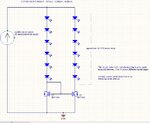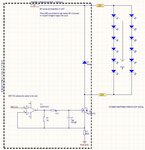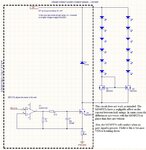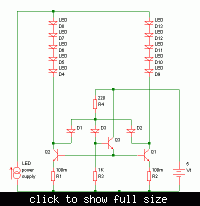jstamour802
Junior Member level 1
Hello,
I tested a N-MOSFET current mirror to drive two LED strings in parallel. This worked well using a constant current power supply:

Next, I have a "pulsed current source" which can output up to 50A, and drive LED strings with up to 100V. The current is limited via a "current sink" type current source tied to the cathode of the LED strings. The "HV" pin shown in FIGURE 2 below can drive anywhere from 10V-100V depending on what types of LEDs are connected. This voltage is configurable depending on the LED type.
Typical wiring connection looks like this:

Pulsed current between the two strings is not equal - much like it is not equal in continuous when connected this way. The differences can be as much as 30% or more depending on the LED!!
So.....I thought I could connect the same NFET current mirror to the output like shown in figure 3:

But this does not work. Current matching is still way off - and the FETs seem to conduct even when I remove the gate signal(s).
Questions:
- Is this a proper current mirror circuit when used with a "current sink" type current source?
- Would a PFET work if wired slightly differently?
- Why does this not work?
- Why does the transistor conduct without a gate signal even though the VDS rating of the FET is 100v?
-
Thanks for any help!
I tested a N-MOSFET current mirror to drive two LED strings in parallel. This worked well using a constant current power supply:

Next, I have a "pulsed current source" which can output up to 50A, and drive LED strings with up to 100V. The current is limited via a "current sink" type current source tied to the cathode of the LED strings. The "HV" pin shown in FIGURE 2 below can drive anywhere from 10V-100V depending on what types of LEDs are connected. This voltage is configurable depending on the LED type.
Typical wiring connection looks like this:

Pulsed current between the two strings is not equal - much like it is not equal in continuous when connected this way. The differences can be as much as 30% or more depending on the LED!!
So.....I thought I could connect the same NFET current mirror to the output like shown in figure 3:

But this does not work. Current matching is still way off - and the FETs seem to conduct even when I remove the gate signal(s).
Questions:
- Is this a proper current mirror circuit when used with a "current sink" type current source?
- Would a PFET work if wired slightly differently?
- Why does this not work?
- Why does the transistor conduct without a gate signal even though the VDS rating of the FET is 100v?
-
Thanks for any help!
